您好,登錄后才能下訂單哦!
您好,登錄后才能下訂單哦!
Vue如何在不同場景下實現組件間的數據交流?很多新手對此不是很清楚,為了幫助大家解決這個難題,下面小編將為大家詳細講解,有這方面需求的人可以來學習下,希望你能有所收獲。
父子組件間的數據交流
父子組件間的數據交流可分為兩種:
1.父組件傳遞數據給子組件
2.子組件傳遞數據給父組件
父組件傳遞數據給子組件——props
這是組件數據溝通中最常見的場景:你讓父組件掌握了數據源,然后傳遞給子組件,供子組件使用
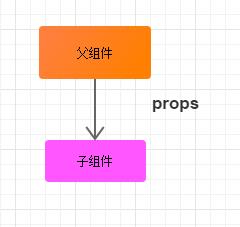
許多人會說,這很簡單!用props嘛! 對,正因如此,它不是我要講的主要內容,不過我們還是用代碼簡單過一遍:
父組件
<template>
<div id="father">
{{ '我是父組件' }}
<son :text = "text"></son>
</div>
</template>
<script>
import son from './son.vue'
export default {
data: function () {
return {
text: '從父組件傳來的數據'
}
},
components: {
son: son
}
}
</script>
<style scoped>
</style>子組件:
<template>
<div>
{{ '我是子組件,我接收了' + text }}
</div>
</template>
<script>
export default {
props: {
text: { type: String, default: '' }
}
}
</script>
<!-- Add "scoped" attribute to limit CSS to this component only -->
<style scoped>
</style>demo:
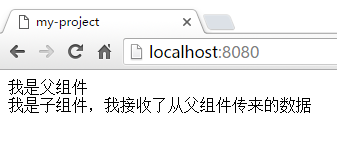
在這個demo里面,我們把“從父組件傳來的數據”這一個字符串通過props傳遞給了子組件
如果我們希望在子組件中改變父組件的數據的話,可以在父組件中定義一個能改變父組件數據的函數,然后通過props將該函數傳遞給子組件,并在子組件在適當時機調用該函數——從而起到在子組件中改變父組件數據的效果
子組件傳遞數據給父組件
子組件傳遞數據給父組件 方式一:回調傳參
父組件:
<template>
<div id="father">
{{ '我是父組件,名稱是' + componentName }}
<son :changeComponentName = "changeComponentName"></son>
</div>
</template>
<script>
import son from './son.vue'
export default {
data: function () {
return {
componentName: '組件A'
}
},
methods: {
changeComponentName: function (newComponentName) {
this.componentName = newComponentName
}
},
components: {
son: son
}
}
</script>
<style scoped>
#father div{
padding: 10px;
margin: 10px;
border: 1px solid gray;
}
</style>子組件:
<template>
<div>
<p>我是子組件:一個button</p>
<button @click="() => changeComponentName(newComponentName)">
把父組件的名稱修改為:彭湖灣的組件
</button>
</div>
</template>
<script>
export default {
data: function () {
return {
newComponentName: '彭湖灣的組件'
}
},
props: {
changeComponentName: {
type: Function,
default: () => { }
}
}
}
</script>
<!-- Add "scoped" attribute to limit CSS to this component only -->
<style scoped>
</style>demo:
點擊前:
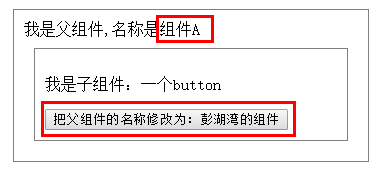
點擊后:
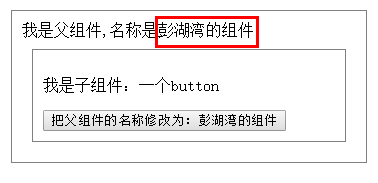
圖解:
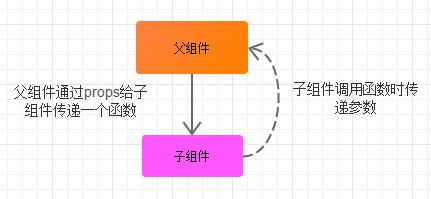
點擊子組件(按鈕)的時候,將父組件的名稱從“A”修改為“彭湖灣的組件”
我們從父組件向子組件傳遞了一個函數(changeComponentName)。并在子組件調用這個函數的時候,以參數的形式傳遞了一個子組件內部的數據(newComponentName)給這個函數,這樣,在父組件中定義的函數(changeComponentName)就可以取得子組件傳來的參數了
【PS】 命名太長不好意思
子組件傳遞數據給父組件 方式二:自定義事件
父組件:
<template>
<div id="father">
<div>
{{ '我是父組件,我的名稱是:' + fatherComponentName }}
<son v-on:changeComponentName = "changeComponentName"></son>
</div>
</div>
</template>
<script>
import son from './son.vue'
export default {
data: function () {
return {
fatherComponentName: 'A組件'
}
},
methods: {
changeComponentName: function (componentName) {
this.fatherComponentName = componentName
}
},
components: {
son: son
}
}
</script>
<style scoped>
#father div{
padding: 10px;
margin: 10px;
border:1px solid grey;
}
</style>子組件:
<template>
<div>
<p>我是子組件:一個按鈕</p>
<button @click="clickCallback">
修改父組件的名稱為:彭湖灣的組件
</button>
</div>
</template>
<script>
export default {
data: function () {
return {
fatherComponentName: '彭湖灣的組件'
}
},
methods: {
clickCallback: function () {
this.$emit('changeComponentName', this.fatherComponentName)
}
}
}
</script>
<!-- Add "scoped" attribute to limit CSS to this component only -->
<style scoped>
</style>demo:
點擊前:
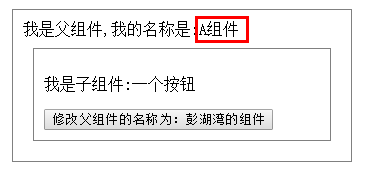
點擊后:
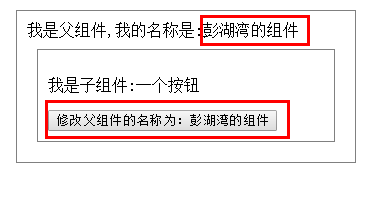
圖解:
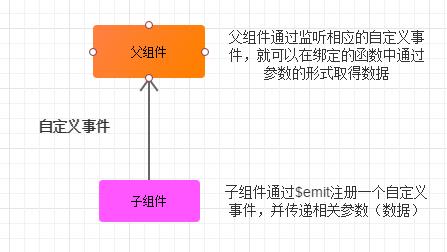
通過$emit(event, [...參數]),所有的參數將被傳遞給監聽器回調,也就是我們在父組件中定義的changeComponentName方法,從而實現從子組件中給父組件傳參
兄弟組件間的數據交流(有共同父組件的兄弟組件)
父組件:
<template>
<div id="father">
<div>
{{ '我是父組件:father' }}
<eldest-son :text = "text"></eldest-son>
<youngest-son :changeText="changeText"></youngest-son>
</div>
</div>
</template>
<script>
import eldestSon from './eldestSon.vue'
import youngestSon from './youngestSon.vue'
export default {
data: function () {
return {
text: '我是一行文本'
}
},
methods: {
changeText: function () {
this.text = '我是經過改動的一行文本'
}
},
components: {
eldestSon: eldestSon,
youngestSon: youngestSon
}
}
</script>
<style>
#father div{
border: 1px solid grey;
padding: 10px;
margin: 10px;
}
</style>兄弟組件1:
<template>
<div>
<p>我是兄弟組件:eldestSon</p>
<p>我有一個可變數據text:{{ text }}</p>
</div>
</template>
<script>
export default {
props: {
text: {
type: String,
default: ''
}
}
}
</script>
<!-- Add "scoped" attribute to limit CSS to this component only -->
<style scoped>
</style>兄弟組件2:
<template>
<div>
<p>我是兄弟組件:youngestSon</p>
<button @click="changeText">更改eldestSon兄弟組件中的文本</button>
</div>
</template>
<script>
export default {
props: {
changeText: {
type: Function,
default: () => {}
}
}
}
</script>
<!-- Add "scoped" attribute to limit CSS to this component only -->
<style scoped>
</style>點擊前:
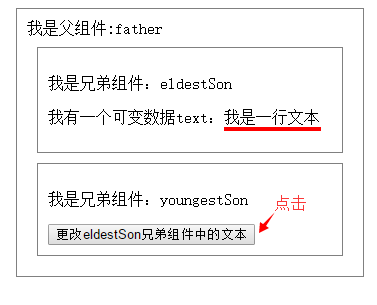
點擊后:
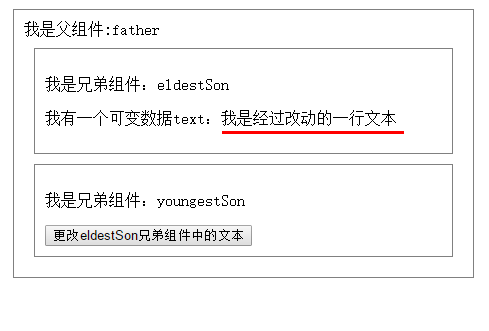
圖解:
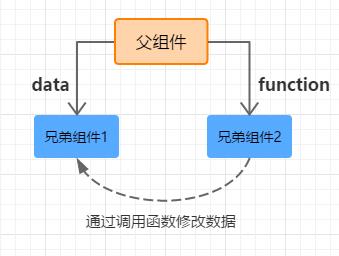
如果兩個兄弟組件間存在這種數據關系的話,我們可以嘗試尋找其共同的父組件,使數據和相關方法“提升”到父組件內部,并向下傳給兩個子組件
這樣,其中一個子組件取得了數據,另外一個子組件取得了改變數據的方法,便可以實現上述的數據溝通
【注意】這種場景存在局限性,它要求兩個組件有共同父組件。對于這種場景之外的處理方法,請看下文
全局組件間的數據交流——Vuex
我上述的許多場景里面,都運用到了props或者函數傳參的方式去處理組件間的數據溝通。然而在稍大型的應用里面,它們都不約而同地給我們帶來了很大的麻煩
例如:
1.通過props從父組件向子組件傳遞數據
對于直接的父子關系的組件,數據流顯得很簡潔明確,但在大型應用里面,我們上下嵌套許多個組件的時候,這就會導致我們的代碼非常地繁瑣,并難以維護
2.對于沒有共同的父組件的兄弟組件,函數傳參的數據傳遞方式也無能為力了,Vue文檔里介紹到,你可以通過以$emit和$on函數為基礎的“事件總線”溝通數據,但它無法應對更加大型的應用
這個時候Vuex就成為了實現全局組件間數據交流的最佳方案了
Vuex擁有一個包含全部頂層狀態的單一數據源(state)
1.所有的組件都可以使用這個單一數據源里面的數據
2.所有的組件都可以通過派發 動作(actions)修改這個單一數據源里的數據
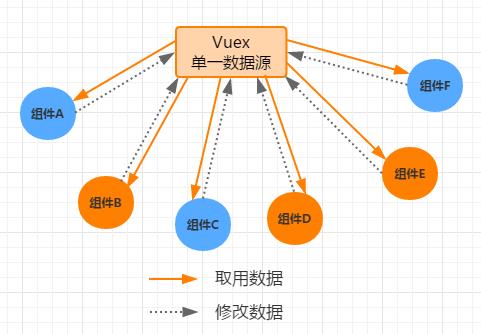
原本要“走很多彎路”才能實現溝通的數據流,一下子就找到了最短的捷徑
實現View層的數據和model層的解耦
在1,2小節中處理的數據(Vue)和第三小節中處理的數據(Vuex),在很多時候是兩種不同類型的數據,前者是屬于View層,僅負責單純的UI展示,而model層的大多是從后端取得后注入的數據。
一點建議:
1.Vue部分的代碼負責構建View層
2.Vuex部分的代碼負責構建model層
(上述的Vue指的是Vuex之外的框架體系)
以上述兩點為基礎,決定某部分的代碼到底要寫進Vue里面還是寫進Vuex里面,并盡量將兩者分開,從而實現View層和model層的解耦,提高前端代碼的可維護性和擴展性
看完上述內容是否對您有幫助呢?如果還想對相關知識有進一步的了解或閱讀更多相關文章,請關注億速云行業資訊頻道,感謝您對億速云的支持。
免責聲明:本站發布的內容(圖片、視頻和文字)以原創、轉載和分享為主,文章觀點不代表本網站立場,如果涉及侵權請聯系站長郵箱:is@yisu.com進行舉報,并提供相關證據,一經查實,將立刻刪除涉嫌侵權內容。